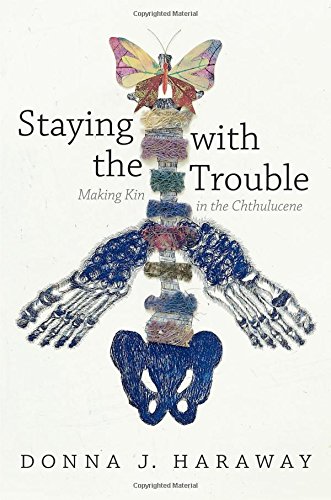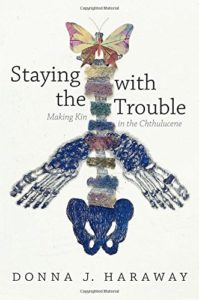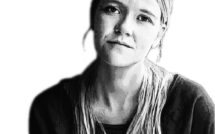

“How can we think in times of urgencies without the self-indulgent and self-fulfilling myths of apocalypse, when every fiber of our being is interlaced, even complicit, in the webs of processes that must somehow be engaged and repatterned?” –Donna Haraway
Haraway’s Staying with the Trouble: Making Kin in the Chthulucene, is very much about the way we think and the things we think with in the urgent time named the Anthropocene, Capitolocene, and Chthulucene. As she asks in the epigraph above, how must we think differently about the current planetary crisis (ecologically, politically, geologically, ethically) so that we do not fulfill an apocalypse we project ourselves? How can we both recognize our complicity in damaging and violent practices while also working to change them?
The book is a challenging exercise in this kind of thinking, one which Haraway calls “staying with the trouble” – a material and ethical practice that is non-innocent – we must acknowledge our complicity in the Anthropocene – while maintaining that the goal is still recuperation. We must imagine the Anthropocene not as an epoch itself but as a geological-historical space we must make as “short/thin as possible” (100), and to “become capable…of response” (1). In each chapter, Haraway engages the feminist techno-scientific thinkers and ideas that have always marked her work, as she stays with different sticky, murky, complicated practices and companions, laying out the ethical dilemmas presented on a damaged planet and making suggestions about how we are to navigate them.
Chapter One, “Playing String Figures with Companion Species” takes pigeons as our guides, tracking their diversity of roles as companions from racing birds, pests and pets, or spies in war. In 2003, racing pigeons participated in a public social experiment that aimed to collect scientific data about air quality in urban spaces. With tiny electronic backpacks, pigeons were able to collect data near power plants, highways, refineries, and other areas of higher pollutions which are often populated by working-class people, immigrants, and people of color (hardly mutually exclusive categories, Haraway notes). The data was meant to supplement existing scientific data that is often collected at fixed altitudes that don’t actually register the quality of breathable air below, or in places far from points of excessive pollution. This feminist practice of making science available to the community itself while also challenging the ways in which scientific data is collected, the project imagined pigeons as co-producers of knowledge in a polluted world. Chapter Two builds on the practices at work in the first chapter, as Haraway refutes notions of bounded individualism and argues instead for a “becoming-with” that is required in what she calls the “Chthulucene.” This term, named for the spider Pimoa Cthulhu (Haraway oddly denies any relation to H.P. Lovecraft’s famed Cthulhu-monster, and points to the way she has changed the spelling to reflect this difference) is meant to evoke the tentacular, snaking, networked relations, an unbounded sense of self and the world. She writes, the “Chthulucene does not close in on itself; it does not round off; its contact zones are ubiquitous and continuously spin out loopy tendrils” (33). Thinking with Ursula LeGuin, Isabelle Stengers, Hannah Arendt, and others, Haraway takes the notion of the “Anthropocene to task” in favor of a term that better opens up ways we might engage the “ongoingness” (49) of the present.
Chapters Three is the last of the long chapters that open the book, and here Haraway culls together Lynn Margulis’ evolutionary theory and developmental biology, Darwin’s orchids, the Hawaiian Bobtail squid and its microbial symbionts, the Black Mesa indigenous land and its polluted past, and the global art project The Crochet Coral Reef. One can really see here how Haraway’s methodology relies on thinking unlikely things together, on collecting scientific research alongside community art, constructing knowledge in the Chthulucene as a diverse, multi-species, trans-disciplinary feminist practice. Chapter Four, “Making Kin,” is a short but perhaps controversial call to “make kin not babies.” Haraway challenges readers to make “kin,” persons not bounded by ancestry or genealogy, outside of normative familial (or species-bound) structures.
Chapter Five, “Awash in Urine,” is one of my favorites of the book for all its tangled ethics and difficult histories. Here, Haraway tells the story of her aging dog, Cayenne, and the medication Haraway began administering to Cayenne for urinary leakage. The drug, diethlystilbesterol (DES), was once administered to pregnant women (1940-1971) in the mistaken belief that it reduced the risk of complications with the pregnancy. Later it was found that the sons and daughters of mothers who took DES had a moderately increased risk of cancer, and the drug was discontinued for human use (though troublingly for Haraway, not for livestock and other animals). Haraway wrestles with her decision to involve herself in the terrible human and animal history of the synthetic estrogen of which she knowingly purchases and gives to her dog for urinary incontinence. “Did I forget, never know, not look – or just not care?” (111), she asks. “There is no innocence in these kin stories” (114), but perhaps more accountability. Haraway will not stop giving her dog DES, though she will be more accountable to the beings and difficult histories of those with whom she is now entangled through her use of the drug.
Chapter Six, “Sowing Worlds,” looks to Ursula LeGuin and Octavia Butler, two prominent feminist science fiction writers. Haraway thinks with them to imagine the ways in which stories are told on a damaged planet, and reads their work alongside work on ants and acacias in evolutionary developmental biology. Like LeGuin’s carrier bag theory of fiction, which collects and carries the stuff of the living, Haraway views her own theoretical-scientific mode of writing as a form of this practice, a sympoesis. Chapter Seven, “A Curious Practice,” continues to probe the kinds of stories we tell, this time with regard to scientific data collection. Haraway details scientist Vinciane Despret’s research methods as a kind of “attunement” or “listening” to the animals and people of her collaborations, which allows her access to a different kind of scientific knowledge. The chapter insists on the fact that “what scientists actually do in the field affects the ways ‘animals see their scientists seeing them’ and therefore affects how the animals respond” (128). This view of field research where scientist and subject of study become-with together is yet another practice that Haraway feels is necessary in the Chthulucene.
The book will likely continue to have wide impact and influence on the fields of feminist science studies, eco-criticism, and the Anthropocene/Capitalocene/Chthulucene. The temporal dimension of the book, the idea of staying-with as opposed to being future-obsessed, marks its departure from either savior or apocalyptic techno-scientific narratives in the sciences. Haraway is clearly engaged with, if not a leader of, feminist, ecologically-minded philosophers like Anna Tsing, Alexis Shotwell, Stacy Alaimo, and Heather Davis, whose work maintains that there are indeed still things we can do, ways we can think, stories we can tell, despite permanent damages done. At the same time, Haraway and others insist on taking stock of human’s complicity in environmental damage and violence, in histories of colonialism and racism. Staying with the trouble is never easy, never innocent. It requires that we do not deny the ways in which we are always and unavoidably knotted into damages and violences, that we must acknowledge these knots if we are to try and reweave, repattern the fabric of the present.
Reviewed by Alison Sperling, Santa Clara University
Staying with the Trouble: Making Kin in the Chthulucene
By Donna Haraway
Publisher: Duke University Press
Paperback / 312 pages / 2016
ISBN: 978-0-8223-6224-1
Published on March 8, 2018.




